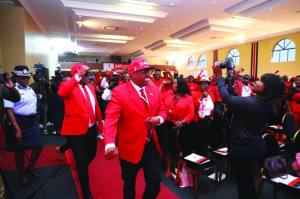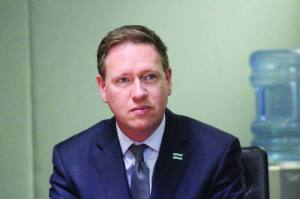World AIDS Day, which falls on December 1, is a day to remember our friends, family, co-workers, and loved ones lost to HIV.
It is also a day to raise awareness about HIV/AIDS and to recognise and support the 360,000 people in Botswana who are living with the virus to ensure they receive the rights and dignity they deserve.
The theme for this year’s World AIDS Day is “Equalise.” This is a global call to action emphasising the importance of ending HIV/AIDS as a public health threat worldwide by addressing inequalities in communities that have been disproportionately affected by the HIV epidemic and other pandemics, including COVID-19.
It is also a call to action ensuring all people living with HIV have access to quality, people-centred HIV prevention and treatment services, and that the diverse voices of all affected ages, genders, and population groups are heard and valued.
The U.S. Embassy is so grateful for our enduring partnership with the Government of Botswana.
The U.S. President’s Emergency Plan for AIDS Relief (PEPFAR) is the largest commitment by any nation to address a single disease internationally.
PEPFAR plays a pivotal role in working with partner countries and other stakeholders to ensure equitable access and services to people living with HIV all around the world.
In addition to life-saving HIV testing, care, and treatment services, PEPFAR prioritises the importance of HIV prevention programming for additional populations that are at greater risk of exposure to HIV, such as adolescent girls and young women, key and vulnerable populations, and prioritised populations, including young men and transient populations.
For 19 years, PEPFAR has provided support to the Government of Botswana through U.S. government agencies such as the Centers for Disease Control and Prevention (CDC), Department of Defense, Peace Corps, and the U.S. Agency for International Development (USAID). Through this partnership with the government and people of Botswana, and with the hard work of our implementing partner organisations, we have worked to save and improve hundreds of thousands of lives, and also to transform our overall HIV/AIDS response. Since PEPFAR’s inception in 2003, Botswana has received more than $1 billion in health assistance from the U.S. Government in the fight against HIV and AIDS. Along with funding, PEPFAR Botswana has provided technical assistance in the areas of prevention, testing, and care and treatment. One of my favourite places to visit in Botswana is Mochudi.
Besides its natural rural beauty, it is also home to Stepping Stones International (SSI), a key U.S. government partner. Over the past 10 years we’ve partnered with SSI on a host of educational and global health programmes to create meaningful opportunities for the youth they serve, including DREAMS. DREAMS provides a comprehensive, multi-sectoral package of core interventions to address key factors that make girls and young women particularly vulnerable to HIV. DREAMS stands for Determined, Resilient, Empowered, AIDS-free, Mentored and Safe. The programme is in the eight highest HIV burdened geographic districts in Botswana: Gaborone, Kgatleng, Southern, Kweneng West, Mahalapye, Serowe, Bobirwa and North East.
The programme began in Botswana in 2017, and I believe it is one of our most exciting achievements in the HIV space. Today, we can celebrate Botswana’s remarkable 95-98-98 achievements in surpassing the UN-AIDS 95-95-95 goals. Currently in Botswana, 95% of all people living with HIV have been tested and know they have HIV, 98% of the people who know their status are on life-saving treatment (Anti-Retroviral Therapy or ART), and 98% of people on ART are virally suppressed. Botswana faced an HIV prevalence rate as high as 30% in 1999, at the peak of the epidemic, but today HIV prevalence has declined to approximately 20%. What an achievement! Today we can also celebrate Botswana’s attainment of the World Health Organisation Silver Tier Status award for elimination of mother to child transmission of HIV.
Botswana has lowered the HIV transmission rate to under five percent for all babies born to HIV-positive mothers and has provided antenatal care and antiretroviral treatment to more than 90% of pregnant women.
Critical to all these successes have been the partnerships between the government of Botswana, civil society organisations, and other multi-lateral stakeholders, including the U.S. government. We applaud government engagement throughout the 19 years of PEPFAR Botswana programming and the importance the government of Botswana has placed on prioritising the health of the nation.
They have done this by ensuring life-saving ART is available to all people immediately after testing positive, including non-citizens through the ‘Treat All” initiative; providing the best antiretroviral regimens available to people on treatment; and decentralising treatment and viral load testing services to bring efficient services closer to people living with HIV. Further, we celebrate the government of Botswana’s dedicated HIV prevention programming for populations at increased risk of acquiring HIV.
This includes prioritising health education, testing, and prevention services, such as pre-exposure prophylaxis (PrEP) for adolescent girls and young women, key populations, and other vulnerable populations by addressing the legal, human rights, gender related, and structural barriers to HIV/ TB services. We applaud the 2019 policy shift by the government of Botswana in providing free ART to non-citizens irrespective of their nationality.
This was particularly impactful for the foreign sex worker population in Botswana. Botswana has done exceptionally well in moving towards ending HIV as a public health threat. That said, we are certainly not done. As shown by the results of the recent Botswana HIV/AIDS Impact Survey (BAIS V), gaps still exist. We must work to address HIV identification gaps within adolescent and male populations aged 25-49; to address gaps in initiating people on treatment, specifically for men aged 25-34 and 40-44; and to close the gaps in viral load suppression amongst adolescents aged 15-19 and adults aged 30-34. We know that additional data is needed to understand the reach of our programming with key and vulnerable populations. Now is the time to say no to stigma and discrimination and to encourage people living with HIV - young and old, rural and urban, business owners and farm hands – to start and stay on treatment. Now is the time to address the harmful power dynamics and gender inequality that hinder progress in reducing new HIV infections amongst adolescents and young women. Now is the time to prioritise prevention programming for marginalised populations throughout Botswana, from Mochudi to Mmadinare. With hard work and continued commitment, we will finish the last leg of this long journey together. *Jacobsen is the U.S. Embassy Chargé d'Affaires







